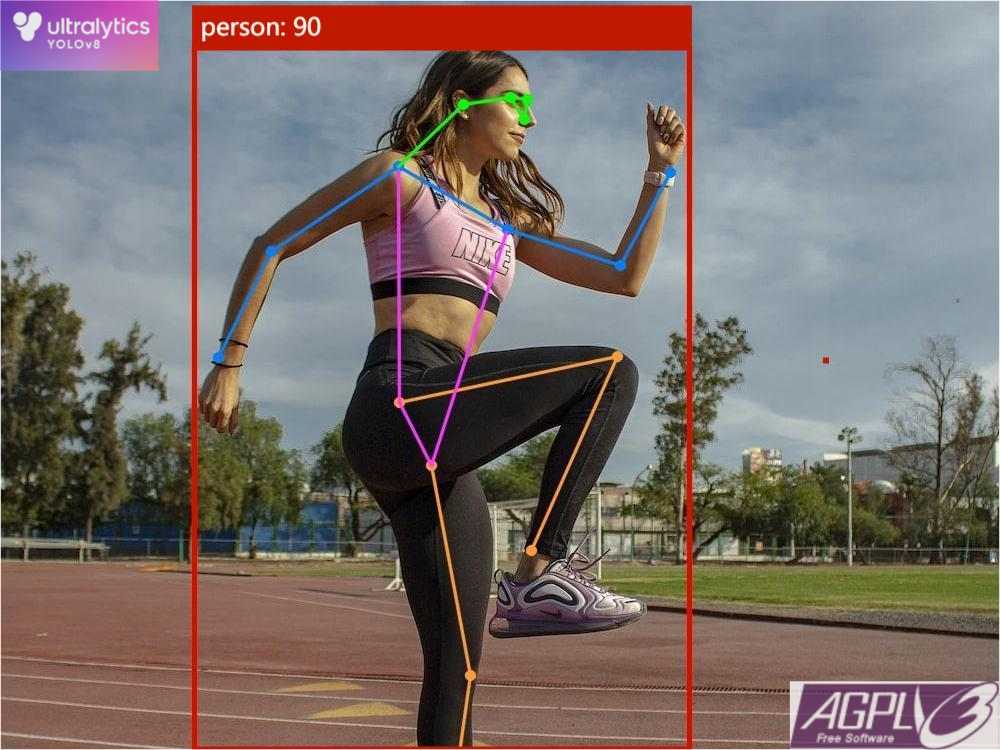YOLOv8姿态估计模型部署

此wiki将介绍如何训练官方的YOLOv8姿态估计模型及将训练好的模型部署到Grove Vision AI(V2)或XIAO ESP32S3设备上。
数据集准备
姿态估计的数据集建议查看YOLOv8官方文档。
安装YOLOv8命令行工具
- 在此默认你已经有了
python的环境与pip包管理工具,且python>=3.8。
# 克隆官方仓库
git clone https://github.com/ultralytics/ultralytics
# 进入到克隆下来的文件夹内
cd ultralytics
# 以开发者模式进行安装,以便后续的修改能够同步
pip install -e .
这里建议使用Git安装的原因是后面需要修改部分代码,所以需要以开发者模型安装
- 可使用版本查询命令测试是否成功安装
yolo命令行工具
# 训练测试
yolo -v
训练
首先切入到所下载的数据集文件夹下
执行以下命令开始训练模型
yolo train detect model=yolov8n-pose.pt data=./data_pose.yaml imgsz=192
导出模型至tflite
训练完成后的模型会再
runs/train/exp*/weights/文件夹下,确认你的模型的评估指标达到你的需求之后需要修改官方代码,减少模型的部分后处理,首先修改
~/ultralytics/ultralytics/nn/modules/head.py文件下Detect和Pose类的forward函数,修改后如下所示
# Detect 类的forward函数
def forward(self, x):
"""Concatenates and returns predicted bounding boxes and class probabilities."""
shape = x[0].shape # BCHW
if self.export:
return [
torch.permute(j, (0, 2, 3, 1)).reshape(j.shape[0], -1, x.shape[1])
for j in [self.cv2[i](x[i]) for i in range(self.nl)]
+ [self.cv3[i](x[i]) for i in range(self.nl)]
]
else:
for i in range(self.nl):
x[i] = torch.cat((self.cv2[i](x[i]), self.cv3[i](x[i])), 1)
if self.training:
return x
elif self.dynamic or self.shape != shape:
self.anchors, self.strides = (
x.transpose(0, 1) for x in make_anchors(x, self.stride, 0.5)
)
self.shape = shape
x_cat = torch.cat([xi.view(shape[0], self.no, -1) for xi in x], 2)
if self.export and self.format in (
"saved_model",
"pb",
"tflite",
"edgetpu",
"tfjs",
): # avoid TF FlexSplitV ops
box = x_cat[:, : self.reg_max * 4]
cls = x_cat[:, self.reg_max * 4 :]
else:
box, cls = x_cat.split((self.reg_max * 4, self.nc), 1)
dbox = (
dist2bbox(self.dfl(box), self.anchors.unsqueeze(0), xywh=True, dim=1)
* self.strides
)
if self.export and self.format in ("tflite", "edgetpu"):
# Normalize xywh with image size to mitigate quantization error of TFLite integer models as done in YOLOv5:
# https://github.com/ultralytics/yolov5/blob/0c8de3fca4a702f8ff5c435e67f378d1fce70243/models/tf.py#L307-L309
# See this PR for details: https://github.com/ultralytics/ultralytics/pull/1695
img_h = shape[2] * self.stride[0]
img_w = shape[3] * self.stride[0]
img_size = torch.tensor(
[img_w, img_h, img_w, img_h], device=dbox.device
).reshape(1, 4, 1)
dbox /= img_size
y = torch.cat((dbox, cls.sigmoid()), 1)
return y if self.export else (y, x)
# Pose类的forward函数
def forward(self, x):
"""Perform forward pass through YOLO model and return predictions."""
bs = x[0].shape[0] # batch size
kpt = torch.cat([self.cv4[i](x[i]).view(bs, self.nk, -1) for i in range(self.nl)], -1) # (bs, 17*3, h*w)
x = self.detect(self, x)
if self.training:
return x, kpt
if self.export:
return x, torch.permute(kpt, (0, 2, 1))
pred_kpt = self.kpts_decode(bs, kpt)
return torch.cat([x, pred_kpt], 1) if self.export else (torch.cat([x[0], pred_kpt], 1), (x[1], kpt))
- 为了命令行不发生异常错误,还可修改
~/ultralytics/ultralytics/engine/exporter.py文件下Exporter类的export_saved_model方法代码如下,
@try_export
def export_saved_model(self, prefix=colorstr('TensorFlow SavedModel:')):
"""YOLOv8 TensorFlow SavedModel export."""
cuda = torch.cuda.is_available()
try:
import tensorflow as tf # noqa
except ImportError:
check_requirements(f"tensorflow{'-macos' if MACOS else '-aarch64' if ARM64 else '' if cuda else '-cpu'}")
import tensorflow as tf # noqa
check_requirements(
('onnx', 'onnx2tf>=1.15.4,<=1.17.5', 'sng4onnx>=1.0.1', 'onnxsim>=0.4.33', 'onnx_graphsurgeon>=0.3.26',
'tflite_support', 'onnxruntime-gpu' if cuda else 'onnxruntime'),
cmds='--extra-index-url https://pypi.ngc.nvidia.com') # onnx_graphsurgeon only on NVIDIA
LOGGER.info(f'\n{prefix} starting export with tensorflow {tf.__version__}...')
check_version(tf.__version__,
'<=2.13.1',
name='tensorflow',
verbose=True,
msg='https://github.com/ultralytics/ultralytics/issues/5161')
f = Path(str(self.file).replace(self.file.suffix, '_saved_model'))
if f.is_dir():
import shutil
shutil.rmtree(f) # delete output folder
# Pre-download calibration file to fix https://github.com/PINTO0309/onnx2tf/issues/545
onnx2tf_file = Path('calibration_image_sample_data_20x128x128x3_float32.npy')
if not onnx2tf_file.exists():
attempt_download_asset(f'{onnx2tf_file}.zip', unzip=True, delete=True)
# Export to ONNX
self.args.simplify = True
f_onnx, _ = self.export_onnx()
# Export to TF
tmp_file = f / 'tmp_tflite_int8_calibration_images.npy' # int8 calibration images file
if self.args.int8:
verbosity = '--verbosity info'
if self.args.data:
# Generate calibration data for integer quantization
LOGGER.info(f"{prefix} collecting INT8 calibration images from 'data={self.args.data}'")
data = check_det_dataset(self.args.data)
dataset = YOLODataset(data['val'], data=data, imgsz=self.imgsz[0], augment=False)
images = []
for i, batch in enumerate(dataset):
if i >= 100: # maximum number of calibration images
break
im = batch['img'].permute(1, 2, 0)[None] # list to nparray, CHW to BHWC
images.append(im)
f.mkdir()
images = torch.cat(images, 0).float()
# mean = images.view(-1, 3).mean(0) # imagenet mean [123.675, 116.28, 103.53]
# std = images.view(-1, 3).std(0) # imagenet std [58.395, 57.12, 57.375]
np.save(str(tmp_file), images.numpy()) # BHWC
int8 = f'-oiqt -qt per-tensor -cind images "{tmp_file}" "[[[[0, 0, 0]]]]" "[[[[255, 255, 255]]]]"'
else:
int8 = '-oiqt -qt per-tensor'
else:
verbosity = '--non_verbose'
int8 = ''
cmd = f'onnx2tf -i "{f_onnx}" -o "{f}" -nuo {verbosity} {int8}'.strip()
LOGGER.info(f"{prefix} running '{cmd}'")
subprocess.run(cmd, shell=True)
yaml_save(f / 'metadata.yaml', self.metadata) # add metadata.yaml
# Remove/rename TFLite models
if self.args.int8:
tmp_file.unlink(missing_ok=True)
for file in f.rglob('*_dynamic_range_quant.tflite'):
file.rename(file.with_name(file.stem.replace('_dynamic_range_quant', '_int8') + file.suffix))
for file in f.rglob('*_integer_quant_with_int16_act.tflite'):
file.unlink() # delete extra fp16 activation TFLite files
# Add TFLite metadata
# for file in f.rglob('*.tflite'):
# f.unlink() if 'quant_with_int16_act.tflite' in str(f) else self._add_tflite_metadata(file)
return str(f), tf.saved_model.load(f, tags=None, options=None) # load saved_model as Keras model
- 使用以下命令可导出tflite模型
yolo export model=${你的模型路径} format=tflite imgsz=192 int8
- 之后会再所在文件夹下看到一个
yolov8n-pose_saved_model的文件夹,里面含有yolov8n-pose_full_integer_quant.tflite模型文件,可将此模型文件部署到Grove Vision AI(V2)或XIAO ESP32S3设备上。
模型图优化
Grove Vision AI(V2)支持使用vela优化后的模型,同时也能加速模型的推理,首先执行以下命令安装vela命令行工具(XIAO ESP32S3设备暂不支持)
pip3 install ethos-u-vela
- 之后需要下载
vela相关的配置文件,或者复制下列的内容到一个文件内,可命名为vela_config.ini
; file: my_vela_cfg.ini ; -----------------------------------------------------------------------------
; Vela configuration file ; -----------------------------------------------------------------------------
; System Configuration
; My_Sys_Cfg
[System_Config.My_Sys_Cfg]
core_clock=400e6
axi0_port=Sram
axi1_port=OffChipFlash
Sram_clock_scale=1.0
Sram_burst_length=32
Sram_read_latency=16
Sram_write_latency=16
Dram_clock_scale=0.75
Dram_burst_length=128
Dram_read_latency=500
Dram_write_latency=250
OnChipFlash_clock_scale=0.25
OffChipFlash_clock_scale=0.015625
OffChipFlash_burst_length=32
OffChipFlash_read_latency=64
OffChipFlash_write_latency=64
; -----------------------------------------------------------------------------
; Memory Mode
; My_Mem_Mode_Parent
[Memory_Mode.My_Mem_Mode_Parent]
const_mem_area=Axi1
arena_mem_area=Axi0
cache_mem_area=Axi0
- 最后使用以下命令,进行图优化
vela --accelerator-config ethos-u55-64 \
--config vela_config.ini \
--system-config My_Sys_Cfg \
--memory-mode My_Mem_Mode_Parent \
--output-dir ${优化后的模型保存路径} \
${需要被优化的tflite模型路径}
部署
需要部署的模型文件是以上导出的
tflite文件,可根据以下教程将模型文件烧录至目标设备我们强烈建议使用我们的网页工具将训练好的tflite模型烧录到设备中,其详细操作我们提供的部署教程进行
注意:由于ESP32S3设备不支持经过vela图优化后的模型部署,因此如果你想将模型部署到XIAO ESP32S3设备上不需要进行tflite模型图优化。